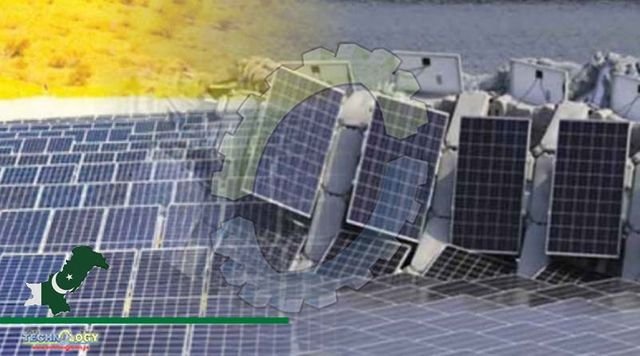Solar PV plants with a total of 8,000-megawatt capacity are projected to be installed in Pakistan by the year 2030. Based on a typical plant of 50MW, it would mean 160 solar PV plants. Solar PVs are best installed near the point of consumption to save cost, transmission assets and losses.

Although solar PV is a solution promising self-sufficiency in energy eventually, it is land intensive. The risk is that it may divert useful land away from important uses like agriculture, housing, etc. Also, the land near energy users is usually expensive, causing increase in solar energy cost. Thus, any solution that avoids this land diversion may be welcome. Solar-on-water (SoW)/ Solar-on-canals and other water bodies fit adequately in this context. SoW also reduces water evaporation losses. We will discuss here the scope and potential of this useful technology in the context of Pakistan.
Pakistan is among 36 water-stressed countries of the world with the lowest annual precipitation of 464 mm in South Asia, which is only one-third to one-fourth of the corresponding average figure in South Asia. Also per capita water availability has been going down by the day and it may reach a low of 500 cubic metres per year by 2025, which would classify Pakistan into a water-scarce country. The only way to increase net water supply is to increase water efficiency, which involves reducing water leakages and losses, and increasing productivity.
Water productivity in Pakistan is also low at one-third of India. Water losses are also high. There are two major sources of water losses – evaporation and conveyance losses. Evaporation and associated losses in Pakistan have been estimated at 15 million acre feet (MAF) as against total water supply of 193 MAF (there may be some variance in data depending on the data year and source). Water loss reduction should be a major objective if water availability is to be increased. Pakistan has one of the largest canal irrigation systems. Water bodies like dam reservoirs and canals are the main sources of evaporation losses. If these water bodies are covered from sun, evaporation losses can be minimised. Floating solar and canal-top solar PVs are two technological mechanisms to achieve this. Pakistan has many major reservoirs/ dams like Tarbela and Mangla and several others like Bhasha, Munda, etc are under planning. Floating solar PV can be installed on the surface of these water bodies.
The country’s many inland lakes and reservoirs are now home to 73 of the world’s 100 largest floating solar plants and account for half of those plants’ 246 megawatts of solar capacity. The largest project currently under way is in South Korea, with a planned capex of $4 billion on a 2.1GW installation to be operational by 2025. It is 14 times the size of the 150MW Huainan solar farm in Korea itself, currently the biggest operational floating solar farm in the world. In the US, California is developing a solar PV on canal system. California has an arid climate and has a well-developed irrigation system ala South Asia.
A 2.1GW solar-on-canals project is at an advanced stage of implementation there. Admittedly, there is still wait and see attitude in other jurisdictions. There are several advantages of canal solar. Firstly, otherwise useable agricultural land is saved; secondly, it saves land cost which saving, although, is neutralised by higher steel structure cost; thirdly, electricity is produced near the agricultural and rural users which, otherwise, may not get access to electricity due to being off the grid; fourthly, transmission and distribution cost is reduced involving low voltage grid; fifthly, there is water efficiency in the sense that water is available in the canals for washing solar panels and the excess overflow water is recycled back to the canal without any formal arrangements; sixthly, electricity is drawn at an interval of short distances by installing relatively smaller inverters at short distances; and finally, there is cooling near the solar PV panels due to water ambience which increases energy yield by 1-2%.
Floating solar PV on water reservoirs/ dams offers additional advantages of hybridising with hydropower and smoothing power supplies. Also, co-utilisation of the transmission facilities of hydro plants is also made available. There may be some limitations as well. Canal orientations may not allow southward orientation. Some canals may not be lined requiring annual cleaning which would prohibit installations in such cases.
A parallel road may have to be provided to aid maintenance activities. All of these tend to increase cost or affect efficiency. Floating power plant had been conceived by Wapda in 2015 to be installed on Tarbela reservoir under a World Bank technical assistance progamme for Tarbela extension. The locations list was later expanded to include Ghazi Barotha, Khanpur Dam and Attock. Recently, EOI have been invited for consultancy (design and construction supervision) of 300MW power plant project.
Pakistan’s target for solar by 2030 is around 8,000MW. It appears that depending upon location issues and land prices, solar-on-canals may have a market potential of 1,000MW by 2030. It may more than double in the period 2030-2040. The floating Solar PV plants on Tarbela reservoir is under implementation which may serve as a model plant in its category, a model solar-on-canal plant may also be built to assess the feasibility in this category. This work should enable GOP to develop a policy in this respect. It appears that solar-on-water is an idea whose time has arrived after a long wait-and-see attitude. Pakistan appears to be on track for a change.
Source: This news is originally published by tribune